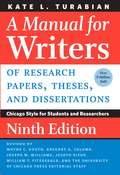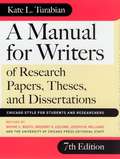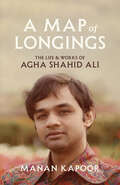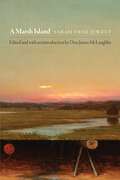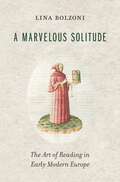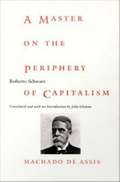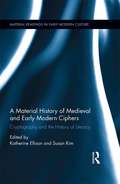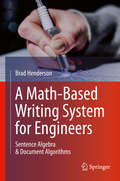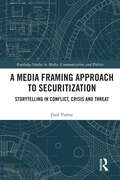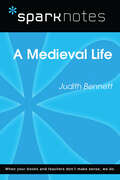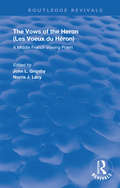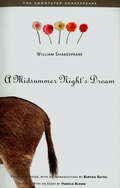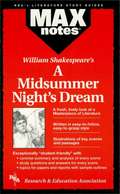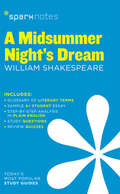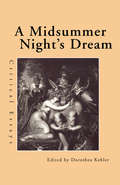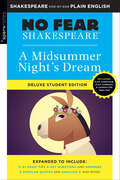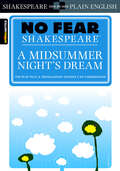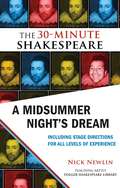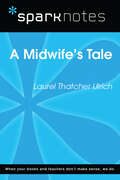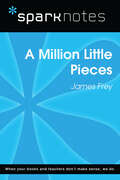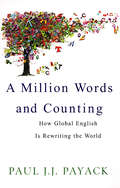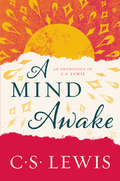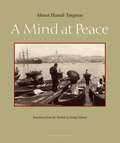- Table View
- List View
A Manual for Writers of Research Papers, Theses, and Dissertations, Ninth Edition: Chicago Style for Students and Researchers (Chicago Guides to Writing, Editing, and Publishing)
by Joseph M. Williams Kate L. Turabian Wayne C. Booth Gregory G. Colomb Joseph Bizup The University of Chicago Press Editorial Staff William T. FitzGeraldWhen Kate L. Turabian first put her famous guidelines to paper, she could hardly have imagined the world in which today’s students would be conducting research. Yet while the ways in which we research and compose papers may have changed, the fundamentals remain the same: writers need to have a strong research question, construct an evidence-based argument, cite their sources, and structure their work in a logical way. A Manual for Writers of Research Papers, Theses, and Dissertations—also known as “Turabian”—remains one of the most popular books for writers because of its timeless focus on achieving these goals. This new edition filters decades of expertise into modern standards. While previous editions incorporated digital forms of research and writing, this edition goes even further to build information literacy, recognizing that most students will be doing their work largely or entirely online and on screens. Chapters include updated advice on finding, evaluating, and citing a wide range of digital sources and also recognize the evolving use of software for citation management, graphics, and paper format and submission. The ninth edition is fully aligned with the recently released Chicago Manual of Style, 17th edition, as well as with the latest edition of The Craft of Research. Teachers and users of the previous editions will recognize the familiar three-part structure. Part 1 covers every step of the research and writing process, including drafting and revising. Part 2 offers a comprehensive guide to Chicago’s two methods of source citation: notes-bibliography and author-date. Part 3 gets into matters of editorial style and the correct way to present quotations and visual material. A Manual for Writers also covers an issue familiar to writers of all levels: how to conquer the fear of tackling a major writing project. Through eight decades and millions of copies, A Manual for Writers has helped generations shape their ideas into compelling research papers. This new edition will continue to be the gold standard for college and graduate students in virtually all academic disciplines.
A Manual for Writers of Research Papers, Theses, and Dissertations: Chicago Style for Students and Researchers (7th edition)
by Joseph M. Williams Kate L. Turabian Wayne C. Booth Gregory G. ColombThis seventh edition of Turabian's "Manual" is a classic reference revised for a new age. It is tailored to a new generation of writers using tools its original author could not have imagined-- while retaining the clarity and authority that generations of scholars have come to associate with the name Turabian.
A Map of Longings: The Life and Works of Agha Shahid Ali
by Manan KapoorThe beautifully written first biography of one of the world’s finest twentieth-century poets Agha Shahid Ali (1949–2001) was one of the most celebrated American poets of the latter twentieth century, and his works have touched millions of lives around the world. Traversing multiple geographies, cultures, religions, and traditions, he mapped the varied landscapes of the Indian subcontinent and the United States. In this biography, Manan Kapoor narrates Shahid’s evolution, following in the footsteps of the “Beloved Witness” from Kashmir and New Delhi to the American Southwest and Massachusetts. He charts Shahid’s friendships with literary figures such as James Merrill, Salman Rushdie, and Edward Said; explores how Shahid responded to events around the world, including the partition of the Indian subcontinent and the AIDS epidemic in America; and draws on unpublished materials and in-depth interviews to reveal the experiences and relationships that informed his poetry. Hailed upon its release in India as “lush” and “poetic,” A Map of Longings is the story of an extraordinary poet, the works he left behind, and the legacy of his singular poetic vision.
A Marsh Island (Q19: The Queer American Nineteenth Century)
by Sarah Orne JewettToward the end of her life, Sarah Orne Jewett (1849–1909) made a surprising disclosure. Instead of the critically lauded The Country of the Pointed Firs, Jewett declared her “best story” to be A Marsh Island (1885), a little-known novel. Why? One reason is that it demonstrates Jewett’s range. Known primarily for her vignettes, Jewett accomplished in these pages a truly great novel. Undoubtedly, another reason lies in the novel’s themes of queer kinship and same-sex domesticity, as enjoyed by the flamboyant protagonist Dick Dale. Written a few years into Jewett’s decades-long companionship with Annie Fields, A Marsh Island echoes Jewett’s determination to split time between her family home in Maine and Fields’s place on Charles Street in Boston. The novel follows the adventures of Dale, a Manhattanite landscape painter in the Great Marsh of northeastern Massachusetts and envisions the latter region’s saltmarsh as a figure for dynamic selfhood: the ever-shifting boundaries between land and sea a model for valuing both individuality and a porous openness to the gifts of others.Jewett’s works played a major role in popularizing the genre of American regionalism and have garnered praise, both in her time and ours, for her skill in rendering the local landscapes and fishing villages along or near the coasts of New England. Just as Jewett brought attention to the unique beauty and value of the Great marsh region, editor Don James McLaughlin reveals a convergence of regionalism and sexuality in Jewett’s work in his introduction. A Marsh Island reminds us that queer kinship has a long tradition of being extended to incorporate queer ecological belonging, and that the meaning of “companionship” itself is enriched when we acknowledge its indebtedness to environment.
A Marvelous Solitude: The Art of Reading in Early Modern Europe (The Bernard Berenson Lectures on the Italian Renaissance Delivered at Villa I Tatti #6)
by Lina BolzoniA preeminent Renaissance scholar illuminates early modern encounters with books, in which literature became a portal to self-awareness and miraculous communion between author and reader.The experience of reading is often presented as personal and transformative—a journey of self-discovery and, perhaps, renewal. In A Marvelous Solitude, Lina Bolzoni examines the early modern roots of this attitude toward the readerly act. Between the fourteenth and sixteenth centuries, European men of letters increasingly came to see books as something more than compendia of knowledge: they could also help readers understand the human condition. As Bolzoni shows, Petrarch, Boccaccio, Machiavelli, Montaigne, and Tasso all presented reading as a private encounter and a dialogue with the author.For many Renaissance intellectuals, reading was instrumental to the construction of the self, which was enriched by contact with other learned men. These readers imagined the book as a mirror image of its author, with whom they held a secret affinity. In their letters to one another, humanists described the book as a body, reflecting the notion that reading literature placed its author in the room with oneself. Reading the work of a deceased author became akin to a necromantic rite, as the writers of bygone times were resurrected and placed in contemporary conversation. The vogue for hanging portraits of authors in libraries and studios ensured that the image of the creator was never far from his words, cementing bonds of friendship across barriers of time.These myths—charming, fragile, and powerful—invested the readerly encounter with miraculous properties that lingered in the hearts of the Romantics. And something of those wonders persists today, in the intimate feeling that reading yet provokes.
A Master on the Periphery of Capitalism: Machado De Assis
by Roberto SchwarzA Master on the Periphery of Capitalism is a translation (from the original Portuguese) of Roberto Schwarz's renowned study of the work of Brazilian novelist Machado de Assis (1839-1908). A leading Brazilian theorist and author of the highly influential notion of "misplaced ideas," Schwarz focuses his literary and cultural analysis on Machado's The Posthumous Memoirs of Brás Cubas, which was published in 1880. Writing in the Marxist tradition, Schwarz investigates in particular how social structure gets internalized as literary form, arguing that Machado's style replicates and reveals the deeply embedded class divisions of nineteenth-century Brazil. Widely acknowledged as the most important novelist to have written in Latin America before 1940, Machado had a surprisingly modern style. Schwarz notes that the unprecedented wit, sarcasm, structural inventiveness, and mercurial changes of tone and subject matter found in The Posthumous Memoirs of Brás Cubas marked a crucial moment in the history of Latin American literature. He argues that Machado's vanguard narrative reflects the Brazilian owner class and its peculiar status in both national and international contexts, and shows why this novel's success was no accident. The author was able to confront some of the most prestigious ideologies of the nineteenth century with some uncomfortable truths, not the least of which was that slavery remained the basis of the Brazilian economy. A Master on the Periphery of Capitalism will appeal to those with interests in Latin American literature, nineteenth century history, and Marxist literary theory.
A Material History of Medieval and Early Modern Ciphers: Cryptography and the History of Literacy (Material Readings in Early Modern Culture)
by Katherine Ellison Susan KimThe first cultural history of early modern cryptography, this collection brings together scholars in history, literature, music, the arts, mathematics, and computer science who study ciphering and deciphering from new materialist, media studies, cognitive studies, disability studies, and other theoretical perspectives. Essays analyze the material forms of ciphering as windows into the cultures of orality, manuscript, print, and publishing, revealing that early modern ciphering, and the complex history that preceded it in the medieval period, not only influenced political and military history but also played a central role in the emergence of the capitalist media state in the West, in religious reformation, and in the scientific revolution. Ciphered communication, whether in etched stone and bone, in musical notae, runic symbols, polyalphabetic substitution, algebraic equations, graphic typographies, or literary metaphors, took place in contested social spaces and offered a means of expression during times of political, economic, and personal upheaval. Ciphering shaped the early history of linguistics as a discipline, and it bridged theological and scientific rhetoric before and during the Reformation. Ciphering was an occult art, a mathematic language, and an aesthetic that influenced music, sculpture, painting, drama, poetry, and the early novel. This collection addresses gaps in cryptographic history, but more significantly, through cultural analyses of the rhetorical situations of ciphering and actual solved and unsolved medieval and early modern ciphers, it traces the influences of cryptographic writing and reading on literacy broadly defined as well as the cultures that generate, resist, and require that literacy. This volume offers a significant contribution to the history of the book, highlighting the broader cultural significance of textual materialities.
A Math-Based Writing System for Engineers: Sentence Algebra & Document Algorithms
by Brad HendersonThis book presents the generative rules for formal written communication, in an engineering context, through the lens of mathematics. Aimed at engineering students headed for careers in industry and professionals needing a “just in time” writing resource, this pragmatic text covers all that engineers need to become successful workplace writers, and leaves out all pedagogical piffle they do not. Organized into three levels of skill-specific instruction, A Math-Based Writing System for Engineers: Sentence Algebra & Document Algorithms guides readers through the process of building accurate, precise sentences to structuring efficient, effective reports. The book’s indexed design provides convenient access for both selective and comprehensive readers, and is ideal for university students; professionals seeking a thorough, “left -brained” treatment of English grammar and “go to” document structures; and ESL engineers at all levels.
A Media Framing Approach to Securitization: Storytelling in Conflict, Crisis and Threat (Routledge Studies in Media, Communication, and Politics)
by Fred VulteePresenting securitization as a communication issue, this book combines media framing with the theory of securitization to explain how the discourse of security informs media content and what happens to policy and public understanding when it does. Because securitization studies the construction of threats to societal structures as well as political-institutional structures, this book addresses security framing as a question of identity and the ability of political-cultural elites and media actors to manipulate it. After setting out how its theories work together, the book turns to news and its effects: How do media accounts make empirical sense of the world when they are bound by the need to make social-cultural sense first? How does "security" look in competing news accounts, and how do securitizing frames affect attitudes toward policies and political elites? Last, the book asks how academics and professionals can address the challenges to a democratic public’s role in decision-making created by the manipulation of security. Bringing together distinct fields within communication studies to reflect on the pressing issue of securitization, this book will be a key resource for scholars and students working in the fields of mass communication, policy studies, critical linguistics and international relations, as well as risk and crisis communication.
A Media Framing Approach to Securitization: Storytelling in Conflict, Crisis and Threat (Routledge Studies in Media, Communication, and Politics)
by Fred VulteePresenting securitization as a communication issue, this book combines media framing with the theory of securitization to explain how the discourse of security informs media content and what happens to policy and public understanding when it does. Because securitization studies the construction of threats to societal structures as well as political-institutional structures, this book addresses security framing as a question of identity and the ability of political-cultural elites and media actors to manipulate it. After setting out how its theories work together, the book turns to news and its effects: How do media accounts make empirical sense of the world when they are bound by the need to make social-cultural sense first? How does "security" look in competing news accounts, and how do securitizing frames affect attitudes toward policies and political elites? Last, the book asks how academics and professionals can address the challenges to a democratic public’s role in decision-making created by the manipulation of security.Bringing together distinct fields within communication studies to reflect on the pressing issue of securitization, this book will be a key resource for scholars and students working in the fields of mass communication, policy studies, critical linguistics and international relations, as well as risk and crisis communication.
A Medieval Life (SparkNotes Literature Guide Series)
by SparkNotesA Medieval Life (SparkNotes Literature Guide) by Judith M. Bennett Making the reading experience fun! Created by Harvard students for students everywhere, SparkNotes is a new breed of study guide: smarter, better, faster. Geared to what today's students need to know, SparkNotes provides: *Chapter-by-chapter analysis *Explanations of key themes, motifs, and symbols *A review quiz and essay topicsLively and accessible, these guides are perfect for late-night studying and writing papers
A Middle French Vowing Poem: A Middle French Vowing Poem (Routledge Revivals)
by Norris J. Lacy John L. GrigsbyPublished in 1992, this text discusses Les Voeux du Heron, a short text, comprising only 442 lines that was popular in the late Middle Ages but is virtually unknown today. This book includes and English translation, as well as a reconstruction of Manuscript U, published in its entirety for the first time.
A Midsummer Night's Dream
by William Shakespeare Mcdougal-Littell Publishing StaffShakespeare's comedy of lovers in the forest, with additional readings and supporting materials.
A Midsummer Night's Dream
by William ShakespeareFrom the hilarious mischief of the elf Puck to the rough humor of the self-centered Bottom and his fellow players, from the palace of Theseus in Athens to the magic wood where fairies play, Shakespeare's marvelous A Midsummer Night's Dream is a play of enchantment and an insightful portrait of the predicaments of love.
A Midsummer Night's Dream (MAXNotes Literature Guides)
by Gail RaeREA's MAXnotes for William Shakespeare's A Midsummer Night's Dream The MAXnotes offers a comprehensive summary and analysis of A Midsummer Night's Dream and a biography of William Shakespeare. Places the events of the play in historical context and discusses each act in detail. Includes study questions and answers along with topics for papers and sample outlines.
A Midsummer Night's Dream SparkNotes Literature Guide (SparkNotes Literature Guide Series #44)
by SparkNotesA Midsummer Night's Dream SparkNotes Literature Guide by William Shakespeare Making the reading experience fun! When a paper is due, and dreaded exams loom, here's the lit-crit help students need to succeed! SparkNotes Literature Guides make studying smarter, better, and faster. They provide chapter-by-chapter analysis; explanations of key themes, motifs, and symbols; a review quiz; and essay topics. Lively and accessible, SparkNotes is perfect for late-night studying and paper writing. Includes:An A+ Essay—an actual literary essay written about the Spark-ed book—to show students how a paper should be written.16 pages devoted to writing a literary essay including: a glossary of literary termsStep-by-step tutoring on how to write a literary essayA feature on how not to plagiarize
A Midsummer Night's Dream: Critical Essays (Shakespeare Criticism #19)
by Dorothea KehlerThis volume traces the modern critical and performance history of this play, one of Shakespeare's most-loved and most-performed comedies. The essay focus on such modern concerns as feminism, deconstruction, textual theory, and queer theory.
A Midsummer Night's Dream: No Fear Shakespeare Deluxe Student Editions - Shakespeare Side-by-Side Plain English (No Fear Shakespeare)
by William Shakespeare SparkNotesShakespeare everyone can understand—now in this new EXPANDED edition of MIDSUMMER NIGHT&’S DREAM! Why fear Shakespeare? By placing the words of the original play next to line-by-line translations in plain English, this popular guide makes Shakespeare accessible to everyone. And now it features expanded literature guide sections that help students study smarter. The expanded sections include: Five Key Questions: Five frequently asked questions about major moments and characters in the play. What Does the Ending Mean?: Is the ending sad, celebratory, ironic . . . or ambivalent? Plot Analysis: What is the play about? How is the story told, and what are the main themes? Why do the characters behave as they do? Study Questions: Questions that guide students as they study for a test or write a paper. Quotes by Theme: Quotes organized by Shakespeare&’s main themes, such as love, death, tyranny, honor, and fate. Quotes by Character: Quotes organized by the play&’s main characters, along with interpretations of their meaning.
A Midsummer Night's Dream: No Fear Shakespeare Side-by-Side Plain English (No Fear Shakespeare)
by William Shakespeare SparkNotesThis No Fear Shakespeare ebook gives you the complete text of A Midsummer Night's Dreamand an easy-to-understand translation.Each No Fear Shakespeare containsThe complete text of the original playA line-by-line translation that puts Shakespeare into everyday languageA complete list of characters with descriptionsPlenty of helpful commentary
A Midsummer Night's Dream: The 30-Minute Shakespeare
by Nick NewlinPlanning a school or amateur Shakespeare production? The best way to experience the plays is to perform them, but getting started can be a challenge: The complete plays are too long and complex, while scene selections or simplified language are too limited."The 30-Minute Shakespeare" is a new series of abridgements that tell the "story" of each play from start to finish while keeping the beauty of Shakespeare's language intact. Specific stage directions and character suggestions give even inexperienced actors the tools to perform Shakespeare with confidence, understanding, and fun!This cutting focuses on three ridiculously funny and vibrant scenes from A MIDSUMMER NIGHT'S DREAM. The first scene starts with Puck mistakenly anointing the eyes of the wrong lovers with love potion, leading to a madcap chase scene between Helena, Lysander, Hermia, and Demetrius. Scene two features Bottom's magical transformation to an ass, always an audience favorite. The final scene is the classic play within a play, where the "Rude Mechanicals" act out with "tragical mirth" the story of Pyramus and Thisbe, with specific comic suggestions for the characters, including Lion chasing Thisbe into the audience!The edition also includes an essay by editor Nick Newlin on how to produce a Shakespeare play with novice actors, and notes about the original production of this abridgement at the Folger Shakespeare Library's annual Student Shakespeare Festival.
A Midwife's Tale (SparkNotes Literature Guide Series)
by SparkNotesA Midwife's Tale (SparkNotes Literature Guide) by Laurel Thatcher Ulrich Making the reading experience fun! Created by Harvard students for students everywhere, SparkNotes is a new breed of study guide: smarter, better, faster. Geared to what today's students need to know, SparkNotes provides: *Chapter-by-chapter analysis *Explanations of key themes, motifs, and symbols *A review quiz and essay topicsLively and accessible, these guides are perfect for late-night studying and writing papers
A Million Little Pieces (SparkNotes Literature Guide Series)
by SparkNotesA Million Little Pieces (SparkNotes Literature Guide) by James Frey Making the reading experience fun! Created by Harvard students for students everywhere, SparkNotes is a new breed of study guide: smarter, better, faster. Geared to what today's students need to know, SparkNotes provides: *Chapter-by-chapter analysis *Explanations of key themes, motifs, and symbols *A review quiz and essay topicsLively and accessible, these guides are perfect for late-night studying and writing papers
A Million Words And Counting: How Global English Is Rewriting The World
by Payack Paul J.From Babel to Babble . . . Everyone is Speaking English In 2007, the English language passed the million-word mark. That shouldn't come as a surprise since over a billion Earthlings speak English (no one knows about other planets, but they probably speak it, too). That makes for a lot of word-coiners (neologists) out there. And where are all these new words coming from? Hollywood? Technology? The Internet? Corporate boardrooms? Youthspeak? How do world events--from tsunamis and hurricanes to political doublespeak and presidential linguistic bumbling--influence the words we use on a daily basis? What do e-mails, text messages, and emoticons contribute to the language? Let WordMan Paul J. J. Payack take you on a global tour of English-speaking worlds--virtual and otherwise: From India, Singapore, and China, to Australia, the U. S. and the U. K. From film, television, fashion, music, politics, sports, games, business, technology and science From TV junkies, fashionistas and sports fans, to amateur historians and linguists And from every other source that contributes to the global tapestry of English Get ready for a whirlwind tour of our increasingly global culture and how it becomes that way. A Million Words? Fundoo! Podcast, Chinglish, truthiness, crunk. Just a year or two ago, these words were gibberish to most English speakers. Today they pop up in everyday conversation worldwide, just four of the ten thousand new words added to the English language every year. Spurred by the universality of the Internet--where it is the de facto lingua franca--and the global reach of its media, English is growing at a rate unprecedented in its 1500-year history. Indeed, in the spring of 2007, the English word count surpassed a million--over ten times the number available in French. At the crest of this linguistic tsunami surfs Paul J. J. Payack, aka the WordMan. As president of the Global Language Monitor, he has tracked the latest developments--the fascinating hybrids, the bizarre etymologies, the lasting malapropisms--in the language shared by two billion of the Earth's citizens. Aided by a worldwide network of similarly obsessed language mavens and armed with his own powerful word-counting algorithm, Payack ensures that no new English word falls from the tongue or marks the page without being counted toward the Million Word March. A Million Words and Counting is a celebration of the vast variety and ever-evolving expressiveness of humanity's most universal language. Fun and informative, this guide is a joyful exploration of English as it spreads across the globe, as it is spoken today, and as it expands into the future. Each entertaining chapter of this ambitious linguistic survey examines another source of new English, including Hollywood, youth culture, other languages, corporate boardrooms, and tongue-tied presidents. An engaging compendium of English-language facts and factoids, this is a trivia lover's goldmine and a logophile's playground.
A Mind Awake: An Anthology of C. S. Lewis
by C. S. LewisA repackaged edition of the revered author’s anthology featuring hundreds of selections from his writings, organized by the main themes of Christian faith.C. S. Lewis—the great British writer, scholar, lay theologian, broadcaster, Christian apologist, and bestselling author of Mere Christianity, The Screwtape Letters, The Great Divorce, The Chronicles of Narnia, and many other beloved classics—wrote widely on all the main themes of Christian faith: God, Jesus, the Trinity, Scripture, sin, evil, nature, sex, the Christian life, prayer, faith, compassion, guilt, and forgiveness. A Mind Awake includes hundreds of short excerpts, curated from the full range of his works and organized them by theme. Useful as both a reference work and as a devotional resource, A Mind Awake contains hidden gems of wisdom that are provocative, whimsical, and insightful, and is an ideal introduction to this towering figure who has profoundly influenced modern Christianity.
A Mind at Peace
by Erdag Goknar Ahmet Hamdi TaniparSurviving the childhood trauma of his parents' untimely deaths in the early skirmishes of World War I, Mümtaz is raised and mentored in Istanbul by his cousin Ihsan and his cosmopolitan family of intellectuals. Having lived through the tumultuous cultural revolutions following the fall of the Ottoman Empire and the rise of the early Turkish Republic, each is challenged by the difficulties brought about by such rapid social change.The promise of modernization and progress has given way to crippling anxiety rather than hope for the future. Fragmentation and destabilization seem the only certainties within the new World where they now find themselves. Mümtaz takes refuge in the fading past, immersing himself in literature and music, but when he falls in love with Nuran, a complex woman with demanding relatives, he is forced to confront the challenges of the World at large. Can their love save them from the turbulent times and protect them from disaster, or will inner obsessions, along with powerful social forces seemingly set against them, tear the couple apart?A Mind at Peace, originally published in 1949 is a magnum opus, a Turkish Ulysses and a lyrical homage to Istanbul. With an innate awareness of how dueling cultural mentalities can lead to the distress of divided selves, Tanpinar gauges this moment in history by masterfully portraying its register on the layered psyches of his Istanbulite characters.
